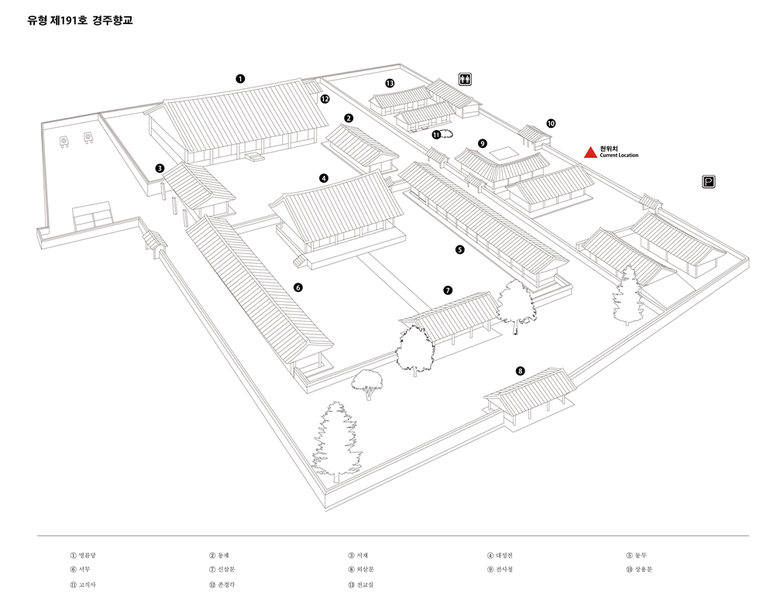"경주향교"의 두 판 사이의 차이
(→갤러리) |
|||
| (사용자 2명의 중간 판 9개는 보이지 않습니다) | |||
| 27번째 줄: | 27번째 줄: | ||
===영문=== | ===영문=== | ||
| − | A ''hyanggyo'' is a local, public education institution of the Goryeo (918-1392) and Joseon (1392-1910) periods. It is usually composed of a lecture hall called Myeongnyundang and a shrine called Daeseongjeon | + | A ''hyanggyo'' is a local, public education institution of the Goryeo (918-1392) and Joseon (1392-1910) periods. It is usually composed of a lecture hall called Myeongnyundang and a shrine called Daeseongjeon. Confucianism was the ruling principle of the Joseon dynasty, and such schools were established in every corner of the country to promote Confucianism during this period. Gyeongjuhyanggyo is the largest local Confucian school in the Gyeongsang-do area, enshrining 25 Confucian sages and men of virtue. |
| − | + | This site had long been home to a national education institution dating back to the 7th century during the Silla period, when Gyeongju was the kingdom's capital. It was on this historic site that Gyeongjuhyanggyo was established at the beginning of the Joseon dynasty. Following its destruction during the Japanese invasions of the 1590s, the school was rebuilt in its current layout in the 17th century. The layout of this complex, placing the shrine in the front and the lecture hall in the back, is typical of local Confucian schools. | |
| − | + | =='''갤러리'''== | |
| + | <gallery mode=packed heights=400px> | ||
| + | 파일:경주향교_배치도.png|경주향교 배치도 | ||
| + | </gallery> | ||
| − | + | * 명륜당 Myeongnyundang Lecture Hall | |
| − | * | + | * 동재 East Dormitory |
| − | ** | + | * 서재 West Dormitory |
| − | * | + | * 대성전 Daeseongjeon Shrine |
| − | * | + | * 동무 East Auxiliary Shrine |
| − | * | + | * 서무 West Auxiliary Shrine |
| − | * | + | * 신삼문 Inner Gate |
| − | * | + | * 외삼문 Outer Gate |
| − | * | + | * 전사청 Ritual Preparation Hall |
| − | * | + | * 상용문 Auxiliary Gate |
| − | * | + | * 고직사 Custodian’s Living Quarters |
| − | * | + | * 존경각 Book Repository |
| + | * 전교실 Head Teacher’s Office | ||
| 50번째 줄: | 54번째 줄: | ||
[[분류:경주시 문화유산]] | [[분류:경주시 문화유산]] | ||
[[분류:시도유형문화재]] | [[분류:시도유형문화재]] | ||
| + | [[분류:경주향교]] | ||
[[분류:향교]] | [[분류:향교]] | ||
| + | [[분류:2018 영문집필]] | ||
2021년 8월 16일 (월) 20:11 기준 최신판
| 경주향교 Gyeongjuhyanggyo Local Confucian School |
|
| 대표명칭 | 경주향교 |
|---|---|
| 영문명칭 | Gyeongjuhyanggyo Local Confucian School |
| 한자 | 慶州鄕校 |
| 주소 | 경상북도 경주시 교동 17-1 |
| 지정번호 | 시도유형문화재 제191호 |
| 지정일 | 1985년 10월 15일 |
| 분류 | 유적건조물/교육문화/교육기관/향교 |
| 수량/면적 | 8동 |
| 웹사이트 | 문화재청 국가문화유산포털 |
|
|
|
해설문
국문
경주향교는 훌륭한 유학자들의 위패를 모시고 제사를 지내며, 지방민의 유학교육과 교화를 위하여 나라에서 지은 국가교육기관입니다. 이 자리에는 신라 최고 중앙교육기관인 국학(國學)이 신문왕 2년(682)에 처음으로 세워졌습니다. 고려시대에는 성종 6년(987)에 지방교육기관인 학원(學院)을 설치하고, 11년(992)에 시설을 정비하였습니다. 조선시대에는 향교로 이어졌는데 성종 23년(1492)에 문묘와 성균관의 배치형식을 따라 다시 지은 현재와 같은 건물배치는 향교의 표본이 되었습니다. 임진왜란 때 불탄 것을 선조 33년(1600)에 대성전을 비롯해 제사를 올리는 제향공간을 다시 지었고, 광해군 6년(1614)에 명륜당 등과 같은 학문을 닦는 강학공간을 고쳐 지었습니다. 광복 후에는 학교의 임시 교사로 활용되었으며 1999년부터는 사회교육원이 개설되어 강학의 맥을 이어오고 있습니다.
건물의 앞쪽에 있는 대성전과 동무·서무는 성현들의 위패를 모시고 제사를 올리는 곳입니다. 뒤쪽에는 강당인 명륜당과 학생들이 거처하며 공부하던 시설인 동재·서재가 있습니다. 교생의 정원은 90인이었으며 경서(經書)와 시문(詩文)을 위주로 가르쳤습니다. 영남에서 가장 규모가 큰 향교로 서울 문묘와 같이 다수의 위패를 모시고 있었습니다.
영문
A hyanggyo is a local, public education institution of the Goryeo (918-1392) and Joseon (1392-1910) periods. It is usually composed of a lecture hall called Myeongnyundang and a shrine called Daeseongjeon. Confucianism was the ruling principle of the Joseon dynasty, and such schools were established in every corner of the country to promote Confucianism during this period. Gyeongjuhyanggyo is the largest local Confucian school in the Gyeongsang-do area, enshrining 25 Confucian sages and men of virtue.
This site had long been home to a national education institution dating back to the 7th century during the Silla period, when Gyeongju was the kingdom's capital. It was on this historic site that Gyeongjuhyanggyo was established at the beginning of the Joseon dynasty. Following its destruction during the Japanese invasions of the 1590s, the school was rebuilt in its current layout in the 17th century. The layout of this complex, placing the shrine in the front and the lecture hall in the back, is typical of local Confucian schools.
갤러리
- 명륜당 Myeongnyundang Lecture Hall
- 동재 East Dormitory
- 서재 West Dormitory
- 대성전 Daeseongjeon Shrine
- 동무 East Auxiliary Shrine
- 서무 West Auxiliary Shrine
- 신삼문 Inner Gate
- 외삼문 Outer Gate
- 전사청 Ritual Preparation Hall
- 상용문 Auxiliary Gate
- 고직사 Custodian’s Living Quarters
- 존경각 Book Repository
- 전교실 Head Teacher’s Office
